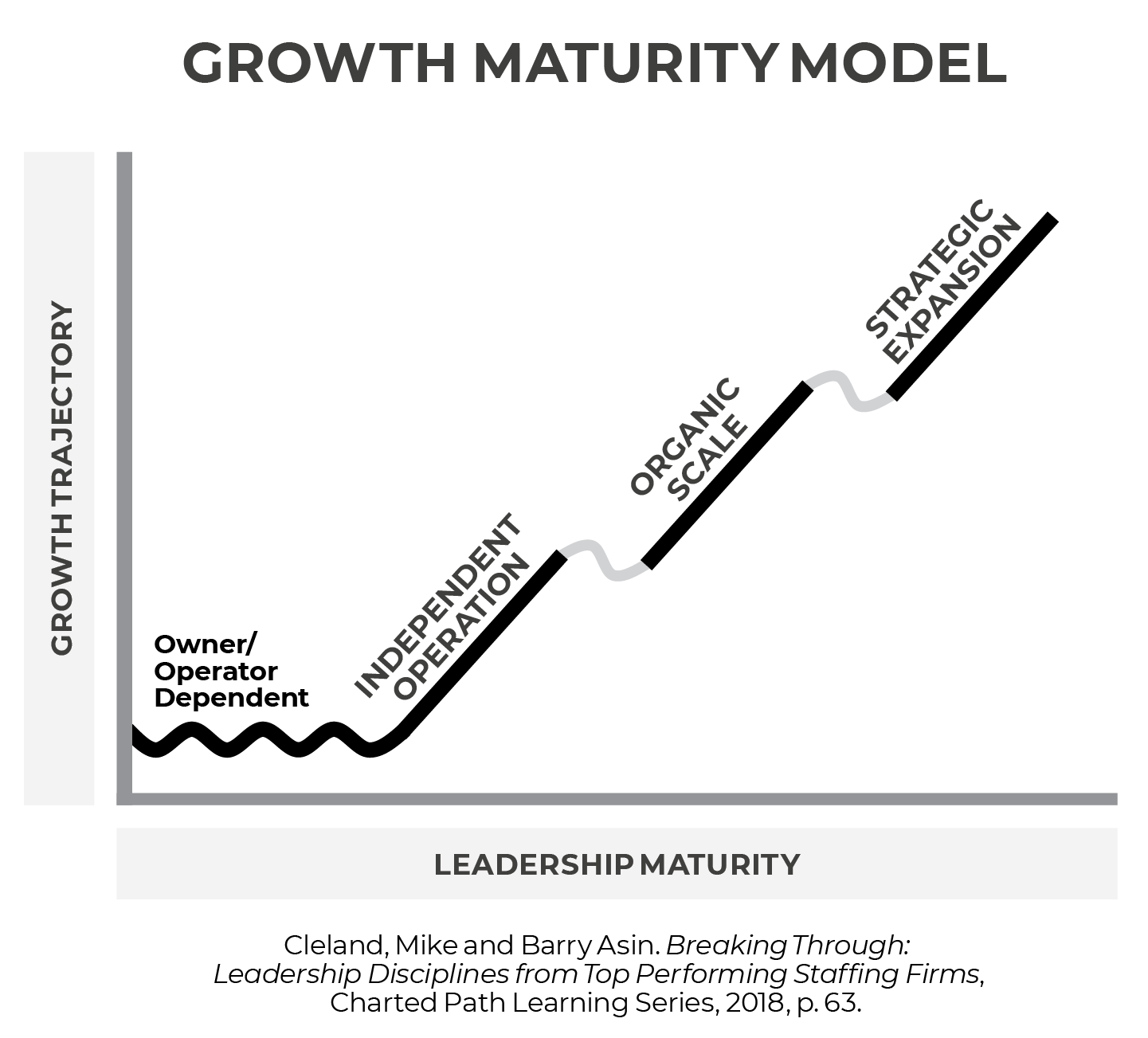The Sixfold Path of Business
Many people are familiar with the Noble Eightfold Path that comes from the Buddhist tradition. While I don’t proclaim to be a Buddhist, I have developed a similar process for building and growing a business. I call it the Sixfold Path of Business. This process is the result of my many leadership roles over the course of a forty-year career in consumer credit, the staffing industry and now marketing. I have refined this process by trial and error, so I readily admit that my ultimate success resulted from a great deal of failure. I find that to be true, however, for most (if not all) of the successful entrepreneurs I know.

So just what is the Sixfold Path of Business? It’s a process or a method that helps a business owner or leader give proper consideration to the building blocks of a successful business. Here is the Sixfold Path:
- Right Team
- Right Structure
- Right Processes
- Right Communication
- Right Accountability
- Right Action
These six areas constitute the primary drivers of effective business leadership. They provide an organized approach to driving growth in the organization, whether small or large. You may believe that culture should be included on any list of important growth items to consider. It certainly is important, but the culture of a company is developed and maintained as a result of the effective execution of these six items. Let’s break them down individually.
Right Team
The most fundamental aspect of an organization is to make sure that, as Jim Collins says in his book Good to Great, you have the “right people on the bus” and then make sure they are in the right seats. The team that surrounds you as a leader will make the difference between an organization growing and exceeding its objectives or one that can’t find the way forward.

Establishing a dynamic team does not mean that you have a collection of like-minded people. The best team will consist of the right person for each role. A Chief Financial Officer will think and talk much differently than the head of Human Resources. And they should.
Another important aspect of the right team involves their willingness to support the mission and objectives of the organization. So, while each team member brings unique skills and talents to their individual role, they must also be united in their common bond to the overall direction of the company. It only takes one person on the team who doesn’t support the mission to cause serious harm to the culture.
Finally, the winning team is composed of people who are great leaders but also coachable. They have a great deal of confidence in their position and in their abilities, but they are equally aware that they can always improve and are open to learning and growing.
Right Structure
Having the right structure deals with the overall organization. What are the reporting relationships? How is the work divided among groups or functions or divisions? Structure is important because it will make the difference between a highly efficient workflow or one that is slow and often breaks down. The interesting thing about organizational structure is that there is no one “right way” to do it. Different companies and products or services call for unique structures that support the work. In some cases, the structure of the company is actually a differentiator that allows the company to stand out from its competitors.

The other important factor to consider about structure is that it must be reviewed regularly as the organization grows. Vibrant companies in growth modes have a path that must be followed. Many companies start off strong but cannot evolve effectively because they become stuck at a certain point. Scaling the organization is a popular phrase often used but it comes with relevant meaning. The Growth Maturity Model here is an offshoot from an article authored by Neil Church and Virginia Lews that appeared in the Harvard Business Review in 1983.

In order to sustain growth, the organization must plan for each new level and adjust their structure accordingly. Only by doing so can long-term growth be maintained.
Right Processes
Establishing effective processes for the key elements of the business is critical. Each company will have different processes that need to be developed, but by identifying the drivers of the business and creating a systematic approach to handling them, a number of benefits are realized:
- Your staff will be more efficient with their time and can optimize their capacity to handle the workload.
- The potential for errors can be reduced and, in many cases, eliminated completely.
- New staff members can quickly be brought up to speed on how each process is handled.
- By developing processes and identifying why each one is important, your staff can then perform the process as well as understand clearly its relevance to success.
- Efficient processes eliminate the need to make unnecessary decisions about what to do and how to do it.
While it is important to have right processes, it is equally important that organizations allow for individual input on the work. People need to have the ability to bring their creativity to the job. In addition, there are some aspects of the work that simply cannot be broken down into a formula. The real challenge for the leaders of the organization is to know what to develop into a process and what to leave to the discretion of a team member. In general, those areas that affect costs and customer outcomes should have strong methods in place, while those that need individual input and creativity can allow for unique engagement by the individual.
Right Communication
The vast majority of businesses have a “failure to communicate.” Assumptions are made, people who need to know are left out and in general, companies simply are not effective at communicating. And, while we’re at it, let’s define what we mean by communication. It’s not just telling someone what to do. Quite often, the most important part of communicating is listening, not talking. But the bottom line here is that the right people need to have the right information in order to do the right thing.

Another shortfall in communication is saying something once and expecting the message to be clearly understood. There is a formula that professional speakers often use to help them guide their presentations:
- Tell the audience what you are going to tell them
- Tell the audience
- Tell the audience what you just told them
So, even in this case, the audience has been told the important information three times. That information may be delivered in three slightly different ways, but the key part of the message is repeated.
Effective communication is equally important with both internal stakeholders and with external audiences.
Right Accountability
Up to this point, the focus has been on creating and maintaining the drivers of productivity – the people and the processes that set the stage for getting the right work done. Right accountability shifts ownership of outcomes to the individuals and the teams doing the work.
Accountability calls for an understanding of what needs to be accomplished. If the organization fails to get the people and process steps completed, accountability for outcomes will be meaningless. It is incumbent on the leadership of the organization to clearly communicate what the expected outcomes are and establish a system for measuring the actual outcomes compared to what was expected. That is the true deliverable when accountability is properly developed.
Being accountable is often considered the hard part of management and leadership, and it certainly can be if not done correctly. Performance expectations must be clearly communicated and revisited on a regular basis. That rhythm can be daily, weekly or monthly, depending on what’s being reviewed and the normal “speed” at which each performance metric travels.

Right Action
Right action is about doing the right thing the right way at the right time. Many business owners and corporate leaders tell their staff to “do the right thing.” But how does one always know what that is? If the organization practices right communication and backs that up with right accountability as has previously been discussed, everyone in the company will know without hesitation what the right thing to do is. And, even if they are not sure, an organization that follows the sixfold path of business will develop a culture that supports and tolerates “not knowing” and backs it up with ways to transition from not knowing to knowing the right action at any given time.
The successful business enterprise supports decision making and taking action. It is automatic and in most cases is what has led to the company’s ongoing success. The ones that get left behind are those that have great plans and give elaborate consideration to their options in any given matter but fail to execute. Here is a simple math question that illustrates right action:
Five frogs are sitting on a log. Four of them decide to jump off. How many frogs are left? You probably answered one, and if you did, I’m sorry, but you answered incorrectly. The correct answer is still five. Why? Because there is a difference between deciding and doing.
Bringing it All Together
The sixfold path of business is a simple — not simplistic — way to lay the groundwork for a company to not only grow but also take the necessary steps along the way to scale the business for each new level that must be achieved to keep the company vibrant and significant. In a way, growing organizations need to periodically reinvent themselves, which flies in the face of the saying “if it ain’t broke, don’t fix it.” There are certain times when even if it “ain’t” broke, it needs to be broken and then fixed. That is the approach of the sixfold path. At each new level of growth, a reassessment needs to take place following the “right” steps:
- Do we currently have the “right team” to move forward?
- Is the current organization structure and business model still serving us well or has it become outdated or inefficient?
- Are the ways we do business (both internally and externally) still meaningful? Do we consider these processes still our “best practices?”
- Is the entire organization communicating effectively and in ways that enhance the team, structure and process? Are there roadblocks preventing good communication?
- Does everyone know what is expected of them and is it measured and reviewed on a regular basis?
- Has the organization become paralyzed into overthinking things and preventing forward movement?
By using this right path, your department, team or company can keep focused on the levers that drive successful outcomes. Doing right becomes being right, and that is never wrong.